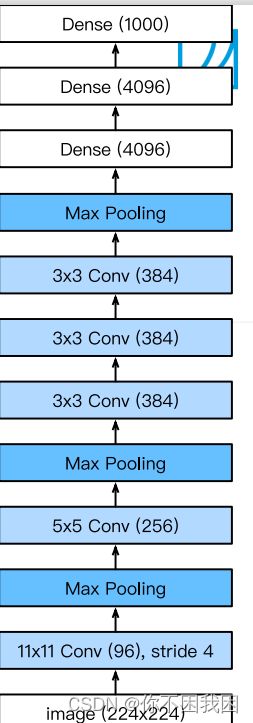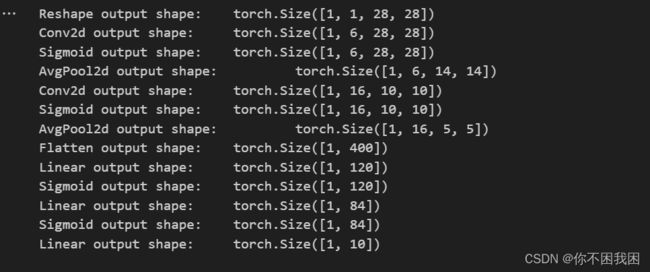一些经典的神经网络(第17天)
1. 经典神经网络LeNet
LeNet是早期成功的神经网络;
先使用卷积层来学习图片空间信息
然后使用全连接层来转到到类别空间

【通过在卷积层后加入激活函数,可以引入非线性、增加模型的表达能力、增强稀疏性和解决梯度消失等问题,从而提高卷积神经网络的性能和效果】
LeNet由两部分组成:卷积编码器和全连接层密集块
import torch
from torch import nn
from d2l import torch as d2l
class Reshape(torch.nn.Module):
def forward(self, x):
return x.view(-1, 1, 28, 28) # 批量数不变,通道数=1,h=28, w=28
net = torch.nn.Sequential(Reshape(),
nn.Conv2d(1, 6, kernel_size=5, padding=2), nn.Sigmoid(), # 在卷积后加激活函数,填充是因为原始处理数据是32*32
nn.AvgPool2d(kernel_size=2, stride=2), # 池化层
nn.Conv2d(6, 16, kernel_size=5), nn.Sigmoid(),
nn.AvgPool2d(kernel_size=2, stride=2),
nn.Flatten(), # 将4D结果拉成向量
# 相当于两个隐藏层的MLP
nn.Linear(16 * 5 * 5, 120), nn.Sigmoid(),
nn.Linear(120, 84), nn.Sigmoid(),
nn.Linear(84, 10))
检查模型
X = torch.rand(size=(1, 1, 28, 28), dtype=torch.float32)
for layer in net:
X = layer(X)
"""
对神经网络 net 中的每一层进行迭代,并打印每一层的输出形状
layer.__class__.__name__ 是获取当前层的类名,即层的类型
"""
print(layer.__class__.__name__, 'output shape: \t', X.shape)
batch_size = 256
train_iter, test_iter = d2l.load_data_fashion_mnist(batch_size=batch_size)
# 对evaluate_accuarcy函数进行轻微的修改
def evaluate_accuracy_gpu(net, data_iter, device=None):
"""使用GPU计算模型在数据集上的精度。"""
if isinstance(net, torch.nn.Module):
net.eval()
if not device:
device = next(iter(net.parameters())).device
metric = d2l.Accumulator(2)
for X, y in data_iter:
if isinstance(X, list):
X = [x.to(device) for x in X]
else:
X = X.to(device)
y = y.to(device)
metric.add(d2l.accuracy(net(X), y), y.numel())
return metric[0] / metric[1] # 分类正确的个数 / 总个数
【
net.to(device) 是将神经网络 net 中的所有参数和缓冲区移动到指定的设备上进行计算的操作。
net 是一个神经网络模型。device 是指定的设备,可以是 torch.device 对象,如 torch.device(‘cuda’) 表示将模型移动到 GPU 上进行计算,或者是字符串,如 ‘cuda:0’ 表示将模型移动到指定编号的 GPU 上进行计算,也可以是 ‘cpu’ 表示将模型移动到 CPU 上进行计算。
通过调用 net.to(device),模型中的所有参数和缓冲区将被复制到指定的设备上,并且之后的计算将在该设备上进行。这样可以利用 GPU 的并行计算能力来加速模型训练和推断过程。
注意,仅仅调用 net.to(device) 并不会对输入数据进行迁移,需要手动将输入数据也移动到相同的设备上才能与模型进行计算。例如,可以使用 input = input.to(device) 将输入数据 input 移动到指定设备上。】
# 为了使用 GPU,我们还需要一点小改动
def train_ch6(net, train_iter, test_iter, num_epochs, lr, device):
"""用GPU训练模型(在第六章定义)。"""
def init_weights(m): # 初始化权重
if type(m) == nn.Linear or type(m) == nn.Conv2d:
nn.init.xavier_uniform_(m.weight)
net.apply(init_weights) # 对整个网络应用初始化
print('training on', device)
net.to(device) # 将神经网络 net 中的所有参数和缓冲区移动到指定的设备上进行计算的操作
optimizer = torch.optim.SGD(net.parameters(), lr=lr) # 定义优化器
loss = nn.CrossEntropyLoss() # 定义损失函数
# 动画效果
animator = d2l.Animator(xlabel='epoch', xlim=[1, num_epochs],
legend=['train loss', 'train acc', 'test acc'])
timer, num_batches = d2l.Timer(), len(train_iter)
for epoch in range(num_epochs):
metric = d2l.Accumulator(3) # metric被初始化为存储3个指标值的累加器
net.train()
for i, (X, y) in enumerate(train_iter):
timer.start()
optimizer.zero_grad()
# 将输入输出数据也移动到相同的设备
X, y = X.to(device), y.to(device)
y_hat = net(X)
l = loss(y_hat, y)
l.backward()
optimizer.step()
with torch.no_grad():
metric.add(l * X.shape[0], d2l.accuracy(y_hat, y), X.shape[0])
timer.stop()
train_l = metric[0] / metric[2]
train_acc = metric[1] / metric[2]
# 动画效果
if (i + 1) % (num_batches // 5) == 0 or i == num_batches - 1:
animator.add(epoch + (i + 1) / num_batches,
(train_l, train_acc, None))
test_acc = evaluate_accuracy_gpu(net, test_iter)
animator.add(epoch + 1, (None, None, test_acc))
print(f'loss {train_l:.3f}, train acc {train_acc:.3f}, '
f'test acc {test_acc:.3f}')
print(f'{metric[2] * num_epochs / timer.sum():.1f} examples/sec '
f'on {str(device)}')
训练和评估LeNet-5模型
lr, num_epochs = 0.9, 10
train_ch6(net, train_iter, test_iter, num_epochs, lr, d2l.try_gpu())
2. 深度卷积神经网络(AlexNet)


AlexNet架构 VS LeNet:
更大的核窗口和步长,因为图片更大了
更大的池化窗口,使用maxpooling
更多的输出通道
添加了3层卷积层
更多的输出
更多细节:
- 激活函数从sigmod变成了Rel(减缓梯度消失)
- 隐藏全连接层后加入了丢弃层dropout
- 数据增强
总结:
- AlexNet是更大更深的LeNet,处理的参数个数和计算复杂度大幅度提升
- 新加入了丢弃法,ReLU激活函数,最大池化层和数据增强
代码实现:
import torch
from torch import nn
from d2l import torch as d2l
net = nn.Sequential(
nn.Conv2d(1, 96, kernel_size=11, stride=4, padding=1), nn.ReLU(), # 在MNIST输入通道是1,在ImageNet测试集上输入为3
nn.MaxPool2d(kernel_size=3, stride=2),
nn.Conv2d(96, 256, kernel_size=5, padding=2), nn.ReLU(), # 相比于LeNet将激活函数改为ReLU
nn.MaxPool2d(kernel_size=3, stride=2),
nn.Conv2d(256, 384, kernel_size=3, padding=1), nn.ReLU(),
nn.Conv2d(384, 384, kernel_size=3, padding=1), nn.ReLU(),
nn.Conv2d(384, 256, kernel_size=3, padding=1), nn.ReLU(),
nn.MaxPool2d(kernel_size=3, stride=2),
nn.Flatten(), # 将4D->2D
nn.Linear(6400, 4096), nn.ReLU(), nn.Dropout(p=0.5), # 添加丢弃
nn.Linear(4096, 4096), nn.ReLU(), nn.Dropout(p=0.5),
nn.Linear(4096, 10)) # 在Fashion-MNIST上做测试所以输出为10
# 构造一个单通道数据,来观察每一层输出的形状
X = torch.randn(1, 1, 224, 224)
for layer in net:
X = layer(X)
print(layer.__class__.__name__, 'Output shape:\t', X.shape)
# Fashion-MNIST图像的分辨率低于ImageNet图像,所以将其增加到224x224
batch_size = 128
train_iter, test_iter = d2l.load_data_fashion_mnist(batch_size, resize=224)
# 训练AlexNet
lr, num_epochs = 0.01, 10
d2l.train_ch6(net, train_iter, test_iter, num_epochs, lr, d2l.try_gpu())


